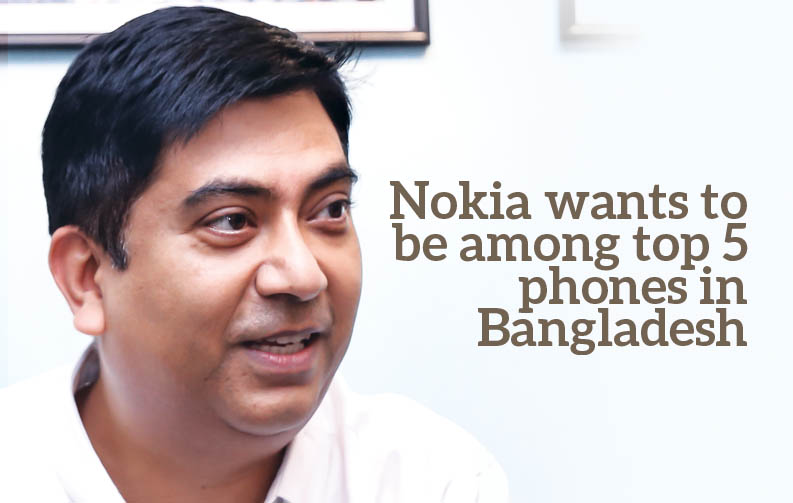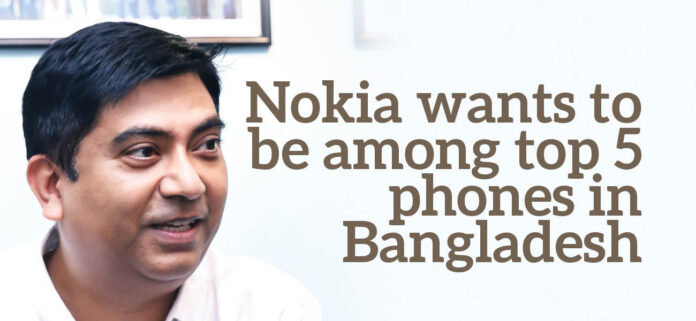Ravi Kunwar, head of Pan Asia for HMD Global, tells Fintech
- Md Habibullah

Nokia used to rule the mobile handset market with hardly any rivals. That heyday of the Finnish company is long over, but it still holds a considerable share of the market through continuous innovations and sturdy designs.
The Fintech recently sat with Ravi Kunwar, head of Pan Asia of HMD Global—the Finnish company that designs and manufactures Nokia smartphones and feature phones. Over a cup of coffee, Kunwar, a charismatic stalwart of the corporate world, shared his ideas and vision to bring back the glory days of Nokia phones.
Here is an excerpt of that interview for our readers.
Tell us about HMD Global’s future plans and vision to explore new opportunities in Bangladesh.
We will continue to build on our leadership in feature phones. We have a global vision where we want to be among the top five smartphone brands in Bangladesh in the next three years. We want to bring more innovations to the market. Design, innovation, and security are three strategic areas where we are going to heavily focus on and invest in.
We will continuously innovate in design, form-factor, and functionality for this segment. We will also continue to challenge the boundaries of feature phones. This vision of HMD will reflect on Bangladesh’s product line-up and business modality in coming days.
How important is the Bangladesh market for HMD Global?
It is very important. The Bangladesh market is a focus market for HMD’s Pan Asia region in both the feature phone and smartphone categories. We will continue to deliver feature phones in each price segment along with budget to mid-range smartphones for this market.
What is Nokia’s current market share/position in Bangladesh?
As a matter of policy, we don’t go about actual figures and numbers. But it can be said that feature phones will continue to lead the Bangladesh market. We are having good growth as far as smartphones are concerned and we are continuously evolving in terms of finding the right business model that can help us succeed. We are very positive about the Bangladesh market.
Is there any growth here compared to last year?
We have seen a remarkable growth in the smartphone segment compared to previous years. The feature phone market is also growing every year.
What are the biggest challenges you face in this market and the impact of the grey market?
We are continuously evaluating the right business model and keeping in touch with the government to do the best thing for the Bangladesh market. The evolution process is always about the right business model. And yes, a lot of pressure is felt in terms of grey products. We see that every time there is a change in any of the duties and taxes, the import of grey products poses a big challenge. So, that’s the industry’s problem, and we are working with the government to resolve it.
Aren’t you crowding up the feature phone segment?
As the feature phone market leader, we are aware of the importance of this type of phones to our consumers. Feature phone shipments have been growing in recent years.
What products have you launched recently?
We have launched multiple products in recent times. We are launching the next generation Nokia 2.3, bringing powerful Al to everyone with a feature-packed dual camera, two-day battery life, and immersive entertainment in a single device, which is available at Tk. 10,999.
Do Nokia smartphones provide any distinct advantage to consumers?
We are the only manufacturer that is 100 per cent committed to having the latest Android across the entire portfolio. Nokia 2.3 is a smartphone for entertainment fans who want to get more from an accessible smartphone. The brand-new ‘Recommended Shot’ camera feature, combined with the two-day battery life and large screen, allows fans to immerse themselves in entertainment and bring out their creative sides.
How does the battery life compare with two other series smartphone models?
We always try to strike a balance between features while designing our new phones. With Android 9 Pie, the battery life is enhanced with features like adaptive battery, which limits battery usage from apps you don’t use often, alongside several other OS optimisations. This coupled with the chipset should enable the Nokia 2.3 battery to last up to two days.








